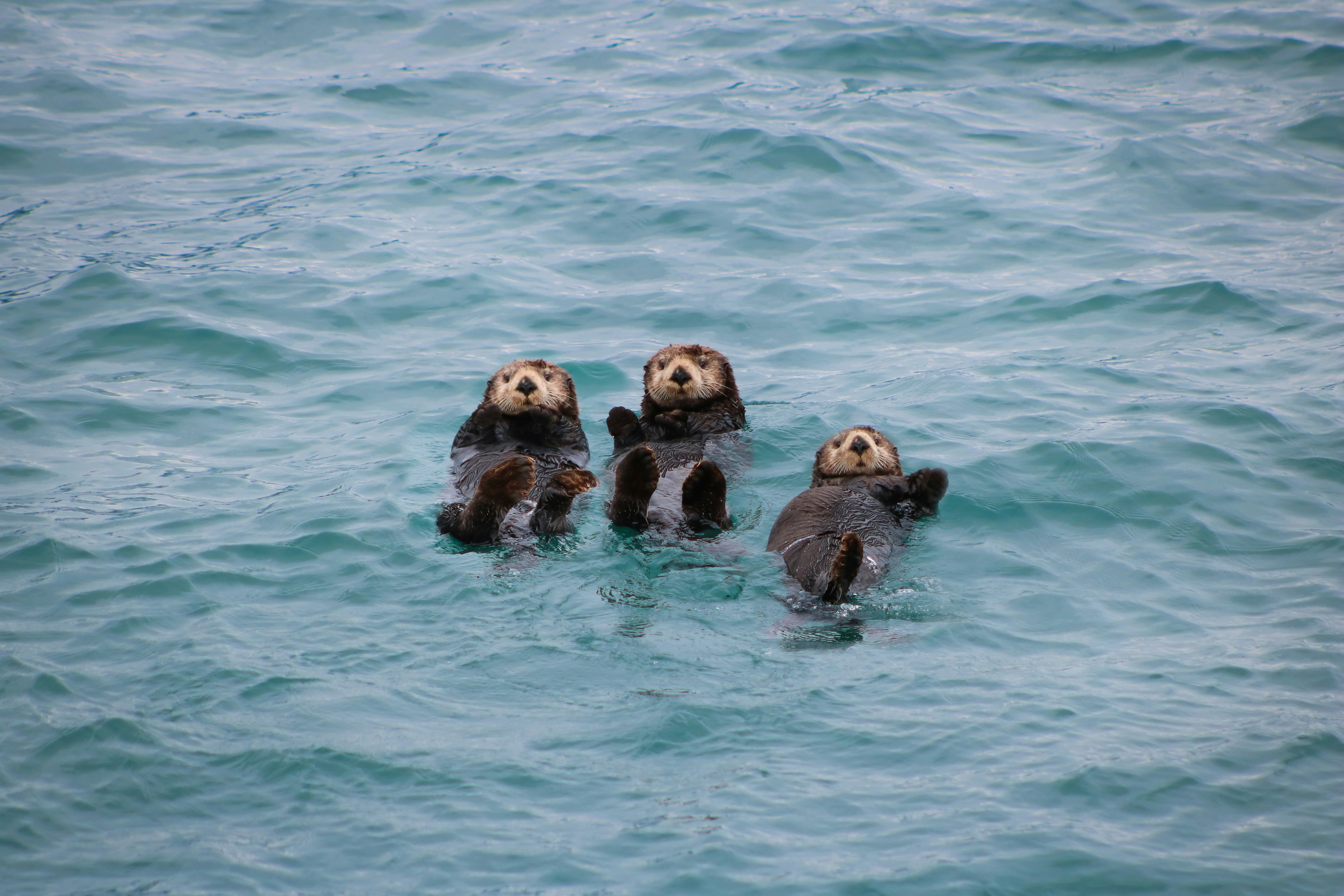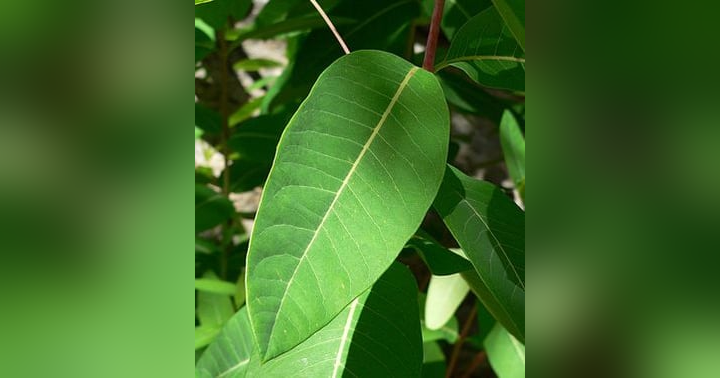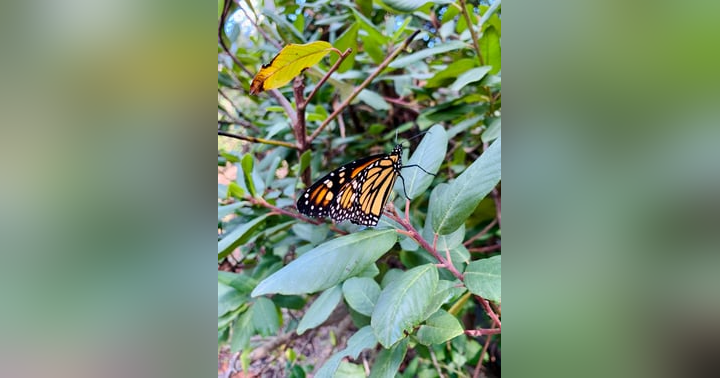How Otters Came Back to Monterey Bay

If you want to see something interesting in nature, it’s always a good idea to look where the people with big, fancy binoculars are looking. At least, this is how I spotted my first sea otter one sunny fall day on the Monterey Peninsula.
I’d been walking the long, sand-dusted boardwalk of Asilomar State Beach, admiring the seaside daisies and pink sand verbena covering the dunes, stopping here and there to take blurry photos of bumblebees with my phone, when I came around a gradual curve in the trail and spotted a little pergola off to one side. There, standing in the shade of the little building was a couple in their seventies taking turns looking at the waves through enormous binoculars.
I followed their gaze and saw only white foam surging over jagged rocks the color of old pennies in the surf. Did they see harbor seals, I wondered? Or maybe they were looking further out, past the break, and could see a pod of dolphins or whales breaching in the distance. I slowed down as I approached, still blind to whatever they were seeing in the water, and paused at the doorway of the little structure.
When I asked what they were looking at, the couple beckoned me into the pergola so warmly I felt as if they knew me, like I was their granddaughter dropping by the house for tea. The silver haired husband handed me the binoculars, reminding me to first look and find what I was looking for and then bring the binoculars to my eyes, while the wife pointed out what might have been a bit of brown driftwood in the tide.
There were a few false starts, bringing the binoculars up and seeing first a bit of rock sticking out of the foam, next a clump of seaweed. But finally, I brought the lenses up to my eyes and saw not the random crest of a wave or the kind of shadow in undulating water that can play tricks on your eyes, but a clever, whiskered face and two little flippers sticking out of the water like the feet of a tall cartoon character sleeping in a too-small bed. I must have exclaimed somehow, because the couple cheered me on and let me watch the otter lying there on its back grooming its luxurious coat.
And that coat is singular in the animal kingdom. Sea otters have the densest fur of any mammal. While the average human has 800-1300 hairs per square inch on our heads, sea otters boast an astonishing 850 thousand to 1 Million hairs in the same amount of real estate.
This mind-boggling density, paired with a combination of longer and shorter hairs, serves a couple of purposes for a sea otter, the first of which you’ll immediately appreciate if you’ve ever speed foot in the Pacific Ocean anywhere north of about Santa Barbara: Warmth.
But it’s not just the dense blanket of fur that keeps otters warm; it’s also the way that fur traps air. Otters spend hours each day grooming their coats and even blow air into them because, when the fur is properly groomed, that air stays trapped, which keeps the animals dry and creates an insulating layer between otter and ocean.
Unfortunately, in the late 1700s, this incredibly special fur attracted the attention of hunters who could get rich on otter pelts, and soon Spanish and Russian hunters, among others, had decimated the sea otter population, in contrast to the Indigenous people who had hunted otters sustainably before the settlers arrived.
As otters became scarce, hunters in Monterey turned to whales, and then abalone, fish, and even algae.
By the early 1900s, the southern sea otter was considered extinct. And around the same time, in 1902, the first sardine cannery in Monterey opened its doors.
For decades, the public continued to believe sea otters extinct. During overlapping decades, a booming canning industry pumped countless gallons of wastewater and rotting fish parts directly into Monterey Bay. This relentless onslaught of overextraction and dumping resulted in a bay so foul smelling that tourism virtually evaporated, so polluted that no one wanted to swim in the water.
Overfishing of the once abundant sardine population was so aggressive during this time that, combined with changing ocean conditions, the fish populations bottomed out in the late 1940s and early 50s. The Bay was a wasteland, a horrific shadow of its former glory.
If you’ve been to Monterey, though, you know that the historic charm of Cannery Row comes with the scent of fresh salt air—not the odor of a Bay choked with putrefying fish parts.
You’ll have seen the Bay’s sandy shore complete with gently lapping waves and tide pools filled with marine invertebrates. And, if you’re lucky, you may have even seen the otters.
The journey from ecosystem shambles to revival involves both the first female mayor of Pacific Grove, Julia Platt, who protected portions of the coastal waters in 1932, and the demise of the canning industry, mainly in the late 1940s through the 50s.
In the early 1960s, decades after Julia Platt died, the first returning otters, once presumed extinct, returned to the exact place Platt had protected all those years ago as mayor. Gaining a foothold there, and restoring kelp forests as they went by controlling the sea urchin populations that had been munching them down, the otters began to branch out into the Bay itself.
Over time, more protections have been placed on the coastal waters of Monterey Bay and surrounding areas. As decades of drastically reduced extraction and pollution have passed, the once uninhabitable stew of rotting sardine parts has transformed into something closer to the once thriving community of 300 years ago.
Back on the Monterey Peninsula that fall day, I spent another moment watching the otter rubbing its fur and rolling gracefully in the water before I handed the binoculars back to my new friends. We all stayed there watching for a while longer until the otter, now just a speck among the distant rocks, flipped over one last time and dove out of sight.
The Monterey Bay today faces plenty of challenges. Many of them brought on by climate change and the urban and agricultural runoff that make their way into the water.
But, when given the proper protection, when helped along and stewarded for biodiversity and ecological health, natural systems that appear to be broken beyond repair can transform once again.
A clearcut can become a forest that, after a while, starts looking a little like old growth. A system of flattened sand dunes can regreen and regrow. And a struggling Bay can once again become home to giant kelp, the fish darting among their swaying blades, the uppermost reaches wrapped around the belly of a sea otter, bobbing gently in the tide.
But how do we go about giving ecosystems a chance to heal, or keep them from needing so much healing in the first place?
Well, the foundation of a healthy ecosystem is a healthy habitat. And In 2020, the State of California became part of an ambitious global movement known as 30x30. Here in California, this means preserving 30% of the state’s lands and coastal waters by 2030. In other words, protecting a lot of habitat, which means more resilience to the many challenges ecosystems are facing today.
And last month, I traveled to San Diego, the most biodiverse county in the continental United States to talk to and learn from some of the incredible leaders making 30x30 a reality.
If you want to hear some of the best things happening in California today, check out this special episode. We’ll go behind the scenes of this year’s 30x30 Partnership Summit to find out more about what 30x30 is, its progress so far, and some of the most exciting conservation success stories today.






